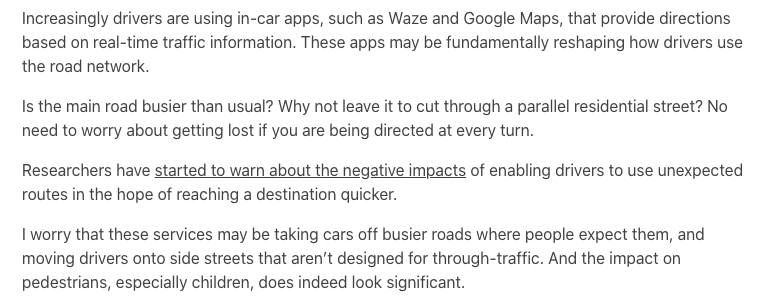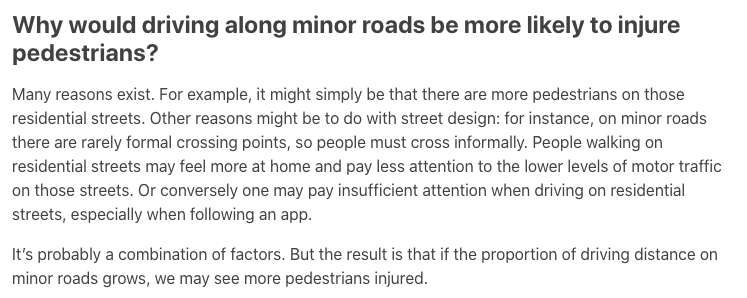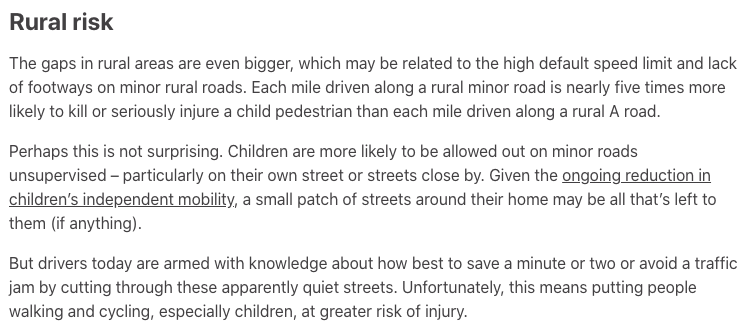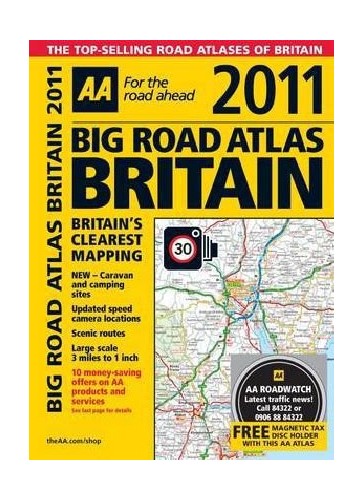
If you’ve been paying even slight attention to the debate around low traffic neighbourhoods, you’ll probably have heard something about the argument of traffic on main and residential roads.
This THREAD explains what this means in the contexts of LTNs.
This THREAD explains what this means in the contexts of LTNs.
Those in favour of low traffic neighbourhood schemes point out that, over the past 10 years traffic on main roads (A or B roads) has decreased, whereas traffic on residential roads has gone up 70%
https://twitter.com/martin_mckee/status/1307391031499984897
They say that this is a result of apps like Google Maps disrupting the ways the roads were designed to be used.
Technology has displaced traffic and the first step in taking control is putting it back on the roads that were designed to handle it.
thetimes.co.uk/article/sat-na…
Technology has displaced traffic and the first step in taking control is putting it back on the roads that were designed to handle it.
thetimes.co.uk/article/sat-na…
Opponents to the scheme say this isn’t fair. Main roads have people living on them too and they already suffer too much congestion. It’s only fair to spread it out so that everyone deals with traffic, regardless of where they live.
(Opponents to LTNs also say that poorer, BAME and vulnerable communities live on main roads but despite tonnes of research and conversations with experts, we’ve found no data to back this up. If you have some, please send it our way).
So supporters and opponents of Low Traffic Neighbourhoods agree on one big thing: there is just too much traffic, and no one deserves to have that much congestion, pollution, and danger in their lives.
We need less cars on our roads.
We need less cars on our roads.
But there’s one fundamental misunderstanding at the heart of the debate around LTNs — and that is that opponents of the schemes think supporters are saying main roads *deserve* this traffic because they’re main roads.
Instead, what supporters are *actually* saying is that traffic belongs on main roads because moving traffic is what those roads were built for, even if folk live there.
To understand what this means, we’re going to dive into research from our favourite academic — @RachelAldred
To understand what this means, we’re going to dive into research from our favourite academic — @RachelAldred
@RachelAldred Aldred’s research shows that cars are the biggest risk for pedestrians and cyclists, and the risk is even higher for disabled and lower-income pedestrians and cyclists on the road. 

@RachelAldred Rather than encouraging these at-risk pedestrians and cyclists to “dress for urban warfare” in high-vis or other shields — Aldred asks how we can create a world where drivers pose less of a risk to other road users. 

@RachelAldred Aldred found that apps like Waze and Google Maps are fundamentally changing how drivers use the roads.
One big change is they’re taking drivers of roads where pedestrians expect them, and putting them on streets which aren’t designed for them.
One big change is they’re taking drivers of roads where pedestrians expect them, and putting them on streets which aren’t designed for them.

@RachelAldred And the result? Each mile driven on an urban residential road results in 17% more deaths or serious injuries to pedestrians than when its driven on a main road. For minor injuries, it goes up 66%. 

@RachelAldred Why is driving on residential roads so much more dangerous? It’s as the LTN advocates say — they’re not designed to handle traffic. What this means in practice is there are more pedestrians, less crossings, and more blind corners. 

@RachelAldred Let's repeat that point -- because it's an important one.
**This has nothing to do with whether or not people live on main roads, what kind of people, or how many people live on them.**
It's to do with the road design -- and how it's meant to be used.
**This has nothing to do with whether or not people live on main roads, what kind of people, or how many people live on them.**
It's to do with the road design -- and how it's meant to be used.
@RachelAldred This means that a driver taking a mile on an urban residential street is twice as likely to kill or seriously injure a child walking, and three times more likely to kill or seriously injure a child on a bike, than if they stuck to the main road. 

@RachelAldred When we get outside of cities and into rural areas the numbers get even more grim. Each mile driven on a residential road is five times more like to injure a child than if they’d driven on the main road. 

@RachelAldred As @RachelAldred concludes, if we are going to have as much traffic as we do, we need to decide whether the safety, health and freedom of our children is an acceptable price to pay for a minor convenience to drivers.
@RachelAldred We at @LambethLivingSt say it isn’t. And that’s why we support low traffic neighbourhoods, in conjunction with other schemes that reduce car dependency in our society.
@RachelAldred The simple fact is there are too many drivers in the UK.
It is up to all of us to get rid of our cars and switch to walking and cycling if we can.
Let’s leave driving to those who have no choice but to do it.
Surely this is something we can all agree on.
It is up to all of us to get rid of our cars and switch to walking and cycling if we can.
Let’s leave driving to those who have no choice but to do it.
Surely this is something we can all agree on.
@RachelAldred Want to read up more on this research yourself? (🤓) Go for it. You can find the link here: sustrans.org.uk/our-blog/opini…
• • •
Missing some Tweet in this thread? You can try to
force a refresh




